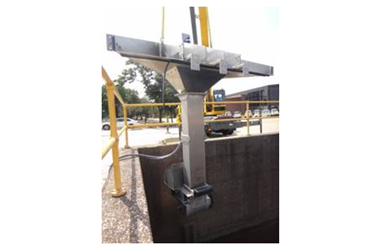Chicago WWTP Discovers How To Harness Extra Energy Of Weir-Falling Water

The Stickney Water Reclamation Plant (WRP), the worl'ds largest wastewater treatment plant (WWTP) in the world, located in Cicero, Ill., has found a method to capture the energy of water falling over a weir to produce electricity in a new application of a "pico turbine."
As water proceeds from one process to another over the normal course of flow at a typical WWTP, it often falls overweirs, which are flat plates of metal set on an edge that allows water to flow over it in a uniform manner. Weirs are used to control water surface elevation in treatment tanks, and when water falls, it releases energy. Until recently, there was no technology small enough to fit into the tanks to capture that energy.
Since the Metropolitan Water Reclamation District of Greater Chicago (MWRD) no longer looks at sewage as a waste product, but instead, as a resource to be recovered and reused, the agency is looking at potential sources of energy throughout its facilities. To this end, the MWRD partnered with the Illinois Sustainable Technology Center at the University of Illinois at Urbana-
Champaign to support the project, "Performance Validation and Demonstration of In-Stream Hydrokinetic Power for Wastewater Treatment Plants," led by Dr. Xinli Lu, project director. The goal of the research project is to demonstrate the ability to generate electricity from flowing and falling water at WWTPs using a new generation of miniature turbines called pico turbines.
A six-month demonstration project is underway at the Stickney facility, which is using a prototype waterfall turbine manufactured by Hydro Holdings of Seattle, Wash. The turbine is installed in an effluent weir structure, where water falls about eight feet to a collection tunnel.
"Hydro Holdings' patent-pending waterfall turbine uses a cross-flow runner design that captures the energy from the water's impact twice as it passes through the turbine blades for high efficiency power generation," explained Jason Rota, project engineer at Hydro Holdings.
The waterfall turbine has been consistently producing an average of 1,200 watts of electricity, under varying flow volumes, since its installation in late August 2013. Hydro Holdings expects that a full-scale unit would produce nearly ten times that amount of electricity. A collection of such pico turbines throughout a WWTP could substantially reduce the plant's electricity bill.
"The MWRD has set an ambitious goal to become energy neutral," said Commissioner Frank Avila, Chairman of the Committee on Engineering. "One step towards this goal is to capture renewable energy from our own processes. It's exciting to see the new innovations helping us to achieve this goal."
MWRD staff that helped bring this project to fruition include, Thomas Kunetz, Assistant Director of Engineering, Project Coordinator; Farsheed Hafezi, Supervising Mechanical Engineer and Ed Jankun, Assistant Master Mechanic, who coordinated the installation of the turbine by the trades; and Reed Dring, ETPO I, who provided operations support.
Source: Stickney Water Reclamation Plant
